Hesham A. Yousef1, A. H. El-Farrash2, A. Magdy2
1Physics Department, Faculty of Science, Suez University, Suez, Egypt
2Physics Department, Faculty of Science, Mansoura University, Mansoura, Egypt
Correspondence to: Hesham A. Yousef, Physics Department, Faculty of Science, Suez University, Suez, Egypt.
| Email: |  |
Copyright © 2017 Scientific & Academic Publishing. All Rights Reserved.
This work is licensed under the Creative Commons Attribution International License (CC BY).
http://creativecommons.org/licenses/by/4.0/

Abstract
It is important to study the distribution of radon concentration in water samples of Manzala Lake, because it is highly contaminated with radon concentration due to the continuous discharge of different pollutant materials into it, which causes pollution in the studied area. Recently, a great interest of the natural radioactivity, especially 222Rn concentrations in water, which is harmful on the human health. The radon concentrations and exhalation rate were measured using nuclear track detectors CR-39 and LR-115 for twenty two water samples from Manzal Lake in the East of Nile Delta, Egypt. The average values of radon concentrations have ranged from 1.73 to 6.40 Bql-1. This work can be used to detect any harmful radiation that would affect the human and assess any changes in the radioactive background level.
Keywords:
Radon, Water, Nuclear Track Detectors, Environment
Cite this paper: Hesham A. Yousef, A. H. El-Farrash, A. Magdy, Radon Levels in Surface Water Samples from Manzala Lake East Nile Delta, Egypt using Nuclear Track Detectors, Journal of Nuclear and Particle Physics, Vol. 7 No. 2, 2017, pp. 36-42. doi: 10.5923/j.jnpp.20170702.03.
1. Introduction
Radon is a radioactive gas emitted from rocks, soils and water. Radon is a major contributor to the ionizing radiation dose received by the general population. We focused on 222Rn because its long half-life (3.82 days) facilitates its escape from the matrix which contained its parent 226Ra. Radon is an important natural radioactive gas harmful, because radon gas comes from the natural decay of uranium series deposits in soil, which is very harmful to human and the environment [1]. The hazard comes from increase radon in an environment, which comes from radon decay products rather than radon gas itself. Geological information may be a useful general guide to identifying areas where radon levels. Radon concentration of water is a potential health risk when the water is used for consumption in house, because radon concentration in air that is inhaled [2]. Measuring radon in water is important, because its solubility in water. The concentration of radon in freshly drawn water higher than that of other radionuclides, it readily diminishes as a result of both desorption and physical decay [3]. Health implication of radon in drinking water is considered an important factor for limiting radon levels in drinking water, which refers to the ingestion of dissolved radon and will result in a radiation dose to the lining of the stomach [4]. Manzala Lake is an important coastal lake and the largest lake in the northern of the Nile Delta, Egypt. It is found between (31° 00'- 31° 35') N and (31° 50'- 32° 15') E. The lake area covers about 1071 km2. The lake receives a high load of different polluted waste water, including industrial and agricultural waste from many drains, like Bahr El-Baqar, Ramses, El-Serw, El-Matria, Faraskur, Lissa El-Gamalia and Hados, so that Manzala Lake is considered one of the most polluted lakes in Egypt [5, 6]. Representative to human activity and different ecosystems in the Lake water environment, in addition to navigation and fishing activities. The main objective of this study is mainly to estimation radon concentration and surface exhalation rate in water samples from Manzala Lake in the North Nile Delta, Egypt, because it is considered one of the most important coastal Lakes in Egypt. In order to assess the change in the radioactive background level in Manzala Lake.
2. Materials and Methods
Twenty two samples from different locations of Manzala Lake were collected as descripted in Table 1. The collected samples were measured using passive technique to determine radon concentration and radon exhalation rate with CR-39 and LR-115 detectors. Samples were collected and analyzed for routine physiochemical properties according to the standard methods [7]. The parameters such as pH, and total dissolved solids (TDS) were measured in the field using a pH meter (CONSORT P903). The water samples were collected from streams and taken within 25 cm of the water surface. All samples were labeled with date, sample location, sample code and time. The samples were collected in polyethylene bottles (6 litters). After this HCl with concentration 10 ml/liter has been added to the bottle to prevent microorganisms and prevent absorption radionuclides by the plastic containers. Before use the containers were washed with 10% HNO3 and with distilled water. The water samples were concentrated by means of active coal absorption and evaporated [8]. All samples were sealed for 90 days in plastic containers with dimensions of 9 cm in diameter and 16 cm in high. Each sample container was capped tightly with an inverted plastic cover. CR-39 and LR-115 detectors of area 1.5 cm x1.5 cm fixed at the bottom center of the inverted plastic cover. After the exposure period CR-39 and LR-115 detectors were collected carefully from the container. CR-39 detector etched in NaOH solution at 6.25N at 70 ± 1°C for 7 hr. After etching CR-39 was washed in distilled water and then dipped for a 10 min in a 3% acetic acid solution, washed again by distilled water and finally dried [9] in air. But LR-115 etched in 2.5 N of NaOH at 60 ± 1°C for 1hr. After the chemical treatment LR-115 was washed in distilled water and then put in a solution of (50 ml water + 50 ml ethyl alcohol) again washed using water and dried in air. After etching CR-39 and LR-115 detectors, the tracks were counted using an optical microscope with a magnification of 640x. The background of CR-39 track detector was counted by optical microscope and subtracted from the count of all detectors [10]. We can calculate the value of radon concentration in (Bql-1) in water using the following relation:  | (1) |
Where, Cw is radon concentration in water (Bql-1), Cair radon concentration in air (Bqm-3), T is the exposure time (day), λ is decay constant of radon gas (0.1814 day-1), h is high of detector from the surface of the water (cm), L is height of the water inside the container (cm) [11].Radon surface exhalation rate given by the relation: | (2) |
Where, EA is exhalation rate (Bqm-2h-1), CRn integrated radon concentration (Bqm-3h), λ radon decay constant (h-1), V is the effective volume of the container (m3), A area covered by the container (m2) and T the exposure time [12, 13].
3. Results and Discussion
The description of water samples locations in Manzala Lake were given by Table 1. The values of radon concentrations and exhalation rate of the collected samples using CR-39 and LR-115 detectors given in Table 2. The values of radon concentration varied from 1.58 to 6.79 Bqm-3 and the values of exhalation rate varied from 0.35 to 0.08Bqm-2h-1 using CR-39 detector. But in the case of LR-115 detector were ranged from1.87 to 6.00 Bqm-3, and 0.10 to 0.31Bqm-2h-1. The comparison between the values of radon concentration using CR-39 and LR-115 were given by Figure 1. From the figure, sample number 17 has a high value because it collected from the end of Bahr El-Baqar drain mixing with Manazal Lake, but sample number 21has low values of the measured samples, because it collected from Boughaz Bridge connect the lake with Mediterranean Sea. This refers to the difference between the chemical compositions and difference in the values of TDS for the studied samples. Figure 2, shows the comparison between surface exhalation rate of radon using CR-39 and LR-115 detectors. The figure indicates that the values of exhalation rate in two detectors near equal, because the values of exhalation rate depend on the radon concentration since the sample area, volume of the container, and radon decay constant. The radon exhalation study is important for understanding the relative contribution of the material to the total radon concentration found in the water samples and helpful to study radon health hazard effects. Table 3, given the values of the total dissolved solid, pH, and the conductivity of the collected samples. The values of TDS ranged from 480-3830 mgl-1, and the conductivity ranged from 0.80 - 7.61mmhos cm-1. And the average value of pH number is equal 8.38. The correlation relation between radon concentration and total dissolved solid (TDS) as shown in Figure 3, and the correlation coefficient equal 0.47. This is a weak correlation, but the values of radon concentration affected by the kind and the values of TDS. Figure 4, shows the relation between electric conductivity and radon concentration from the figure the correlation coefficient equal 0.42 and it depend on the type of total dissolved solid in water samples. Table (1). The water samples locations, and descriptions in Manzala Lake
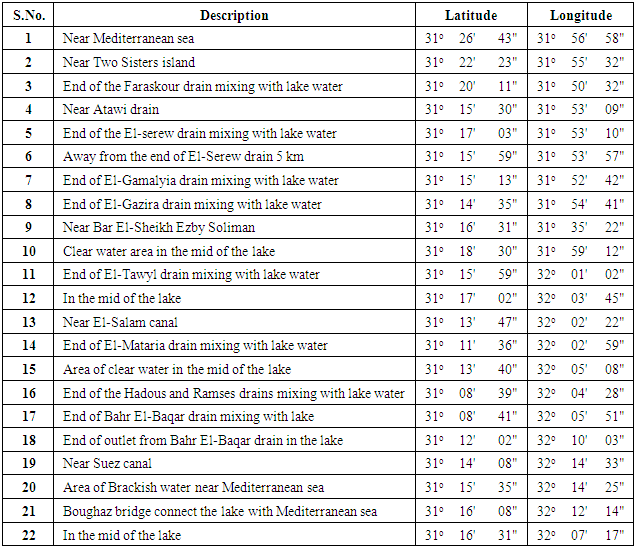 |
| |
|
Table (2). The comparison between the values of radon concentration, and exhalation rate of the water samples using CR-39 and LR-115 detectors
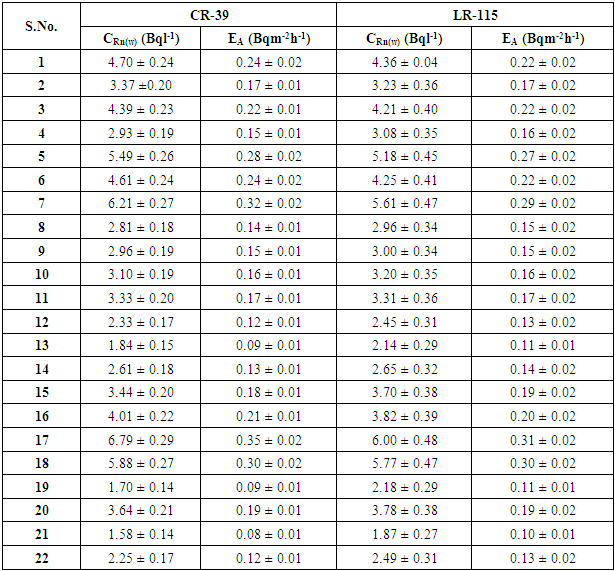 |
| |
|
Table (3). The TDs, pH and conductivity of the water samples
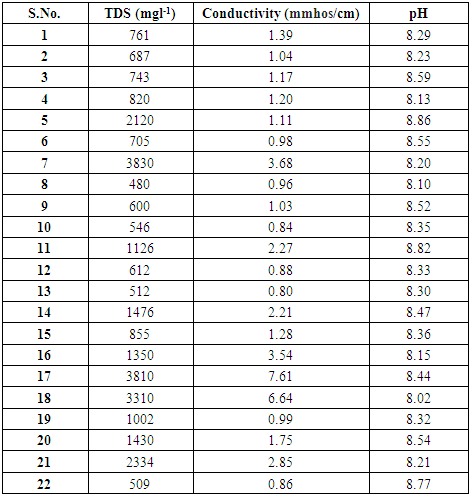 |
| |
|
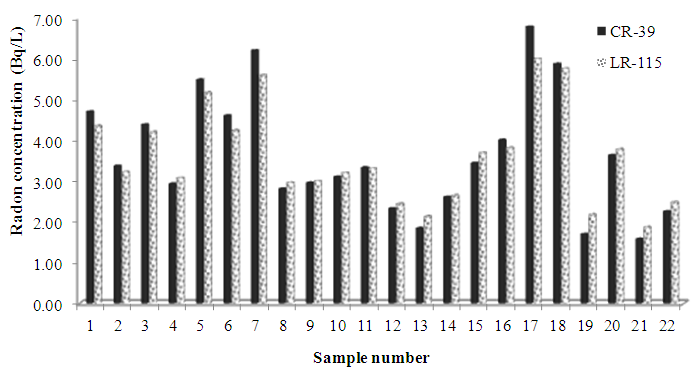 | Figure 1. The comparison between the values of radon concentration using CR-39 and LR-115 detectors |
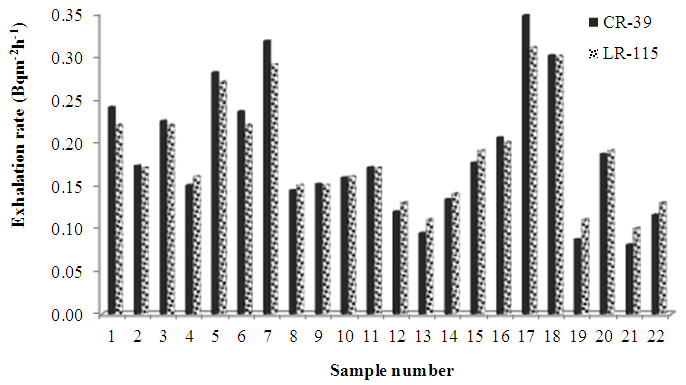 | Figure 2. The comparison between the values of radon exhalation rate using CR-39 and LR-115 detectors |
 | Figure 3. The correlation relation between the values of TDS and radon concentration using CR-39 detector |
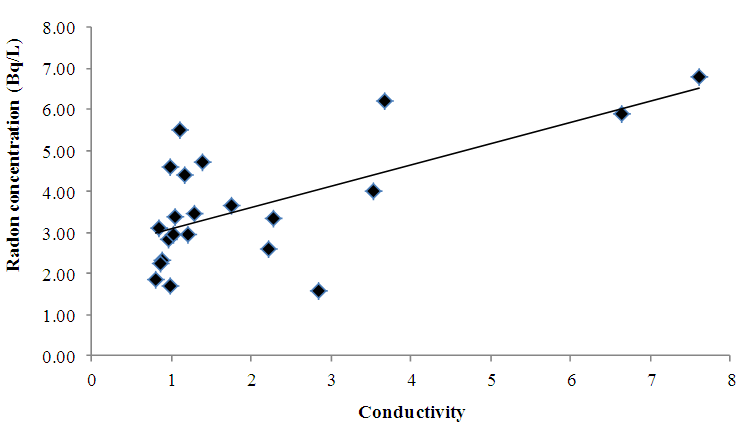 | Figure 4. The correlation relation between conductivity values and radon concentration using CR-39 detector |
There is no correlation between the values of pH number and radon concentration as shown in Figure 5. The obtained results agreement with the published data for other authors in different countries is given in Table 4. The variations in radon concentration refer to the chemical composing of the water samples, the differences in geographical, geological factors, the climate and the geo-hydrological processes that occur in the area. Another reason for this difference may depend on the time of sampling as well as on the location, and this may cause different results.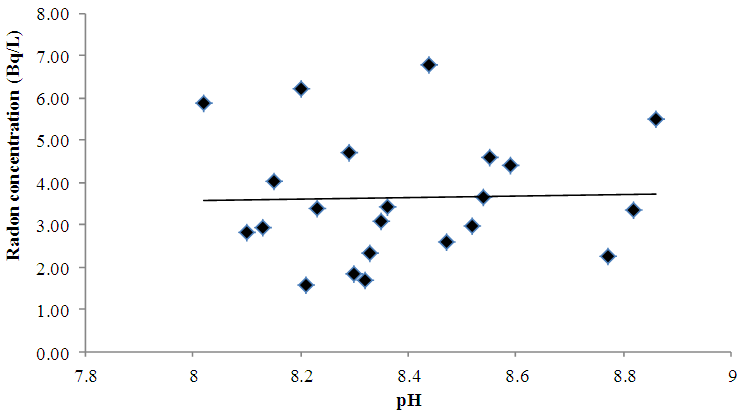 | Figure 5. The correlation relation between pH number and radon concentration using CR-39 detector |
Table (4). The comparison between our results and the published data by other investigators
 |
| |
|
4. Conclusions
It is important to study the distribution of radon concentration in water samples of Manzala Lake, because it is highly contaminated with radon concentration due to the continuous discharge of different pollutant materials into it, which play an important role in causing a severe pollution in the studied area. The obtained results indicate that the radon concentrations in water samples are below the recommended limit of 11.1Bql-1 by the USEPA [20-23]. All samples were found below the recommended level of EPA, which is equal 11 Bql-1 [22]. The values of radon concentration are lower than the recommended level of UNSCEAR [19] which is equal 10 Bql-1. The results of radon using CR-39 and LR-115 detectors are consistent; while the percentage of error in CR-39 is lower than LR-115. The percentage of errors, which are referred to the sensitivity of the detectors, detector material, track density, the etching and counting techniques. CR-39 detector is widely used to measure radon and considered as the best option to measure the indoor radon concentration. We conclude that the results are agreement with the published data in different countries as shown in Table 4. From the previous discussion, the present study can be used as reference information to detect any harmful radiation that would affect the human in the studied area. The lake water can be used as drinking and construction purpose without posing any significant radiological threat to the inhabitants from our point of view.
References
| [1] | Swakon J., et al. Radon concentration in soil gas around local disjunctive tectonic zones in the Krakow area. Environmental Radioactivity. 2005; 78:137- 149. |
| [2] | Nisar Ahmad, Mohamad Suhaimi Jaafar, Mohammed Saad Alsaffar. Study of radon concentration and toxic elements in drinking and irrigated water and its implications in Sungai Petani, Kedah, Malaysia. Journal of Radiation Research and Applied Sciences. 2015; 8: 294-299. |
| [3] | Radioactivity in drinking water: regulations, monitoring results and radiation protection issues. Ann. Ist Super Sanità. 2012; 48(4): 362-373. |
| [4] | Nada Fadhil Tawfiq, Hazim Louis Mansour, and Mahmood Salim Karim. Measurement of Radon Gas Concentrations in Tap Water for Baghdad Governorate by Using Nuclear Track Detector (CR-39). International Journal of Physics. 2015; 3(6): 233-238. |
| [5] | Abd El-Monsef Ahmed El-Badry. Distribution of heavy metals in contaminated water and bottom deposits of Manzala Lake, Egypt. Journal of Environmental and Analytical Toxicology. 2016; 6 (1):1-8. |
| [6] | El-Farrash A. H., Hesham A. Yousef, Abu El-Ela A., Magdy A. Assessment of radon level in soil samples from Manzala Lake East Nile Delta, Egypt using passive technique. International Journal of Scientific Reports. 2016; 2(12): 312-318. |
| [7] | Reemtsma T., and Jekel M. Organic Pollutants in the Water Cycle: Properties, Occurrence, Analysis and Environmental Relevance of Polar Compounds, 2006. |
| [8] | Embaby A. A., Hesham A. Yousef, Laken H. A. Estimation of Radon Levels in Groundwater Samples From Graduate’s Villages in West Nile Delta, Egypt using Alpha Track Detectors. International Journal of Physics and Research. 2016; 6(4) 1-10. |
| [9] | Hesham A. Yousef, Gehad M. Saleh, El-Farrash A. H., Hamza A. Radon exhalation rate for phosphate rocks samples using alpha track detectors. Journal of Radiation Research and Applied Sciences. 2016; 9: 41-46. |
| [10] | Hesham A. Yousef, Embaby A. A., El-Farrash A. H., Laken H. A. Radon exhalation rate in surface soil of graduate's villages in west Nile Delta, Egypt, using can technique. International Journal of Recent Scientific Research. 2015; 4: 3440-3446. |
| [11] | Abdullah M. and Nabil N., 2012. Estimation of natural radioactivity in water and soil some village of Irbid city. Journal of Applied Physics Research, 4 (3) 39- 47. |
| [12] | Rehman S., Imtiaz N., Faheem M. and Matiullah. Determination of 238U contents in ore samples using CR-39 based radon dosimeter disequilibrium case. Radiation Measurements. 2006; 41: 471-476. |
| [13] | Barooah D., Phukan S., Baruah R. Study of radon exhalation rates using LR-115 (II) nuclear track detectors in coal mining area of the foothills of Mokokchung District, Nagaland. Indian Journal of Pure and Applied Physics. 2011; 49: 665-668. |
| [14] | Hussein A. S. Radon measurements in water samples from western desert of Egypt using nuclear track detectors and estimation of corresponding doses. Journal of Radiation Protection and Environment. 2014; 37(3):165-168. |
| [15] | Mohsen B. Challan, Atteyat. A. Labib, A. El-Taher. Measurements of Radon Levels in Ground Water by γ-Ray Spectrometry. Arab Journal of Nuclear Science and Applications. 2016; 94 (1): 21-27. |
| [16] | Sudhir Mittal, Asha Rani, Rohit Mehra. Estimation of radon concentration in soil and groundwater samples of Northern Rajasthan, India. Journal of Radiation Research and Applied Sciences. 2016; 9:125-130. |
| [17] | Ravikumar P., Somashekar R.K. Determination of the radiation dose due to radon ingestion and inhalation. International Journal of Environmental Science and Technology. 2014; 11 (2):493-508. |
| [18] | Mehra R., Badhan K., Sonkawade R.G. Radon Activity Measurements in Drinking Water and in Indoors of Dwellings, Using RAD7. Tenth Radiation Physics & Protection Conference, 27-30 November 2010, Nasr City - Cairo, Egypt. |
| [19] | UNSCEAR, 2000: Sources and effects of ionizing radiation. Report to the General Assembly with scientific annexes, United Nations, New York, 2000. |
| [20] | USEPA, 2012: United States Environmental Protection Agency. Ground water and drinking water. |
| [21] | EPA, 2000: Environmental Protection Agency. Final Rule for Non-Radon Radionuclides in Tap Water, Technical Fact Sheet, EPA, 815-F-00-013, 2000. |
| [22] | WHO, 2008: World Health Organization. Guidelines for drinking-water quality (Vol. 1, pp. 197- 209). |
| [23] | USEPA, 1999: United States Environmental Protection Agency. Office of Water: 40 CFR Parts 141, and 142: National Primary Drinking Water Regulations; radon-222: proposed rule, Washington, 1999. |










 Abstract
Abstract Reference
Reference Full-Text PDF
Full-Text PDF Full-text HTML
Full-text HTML


